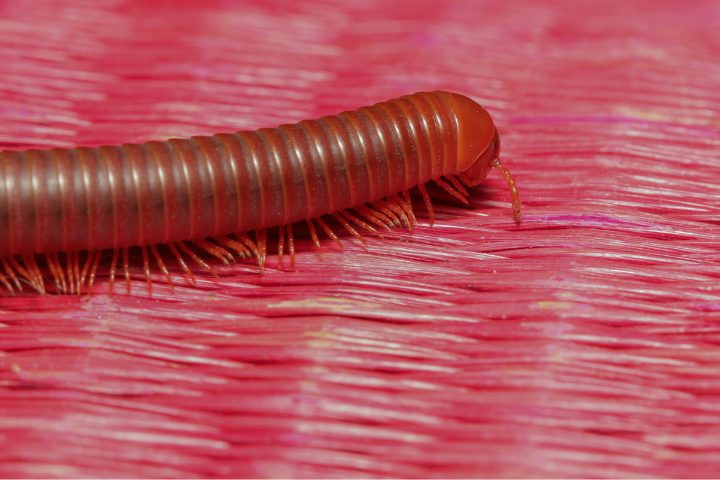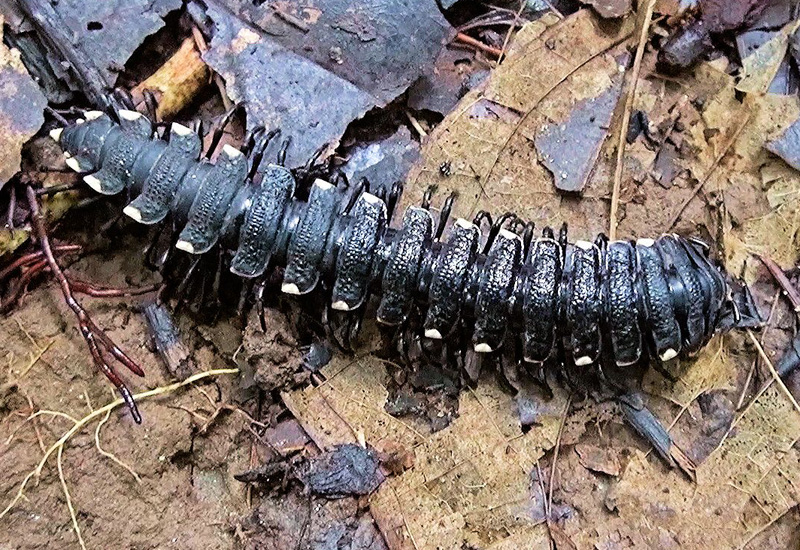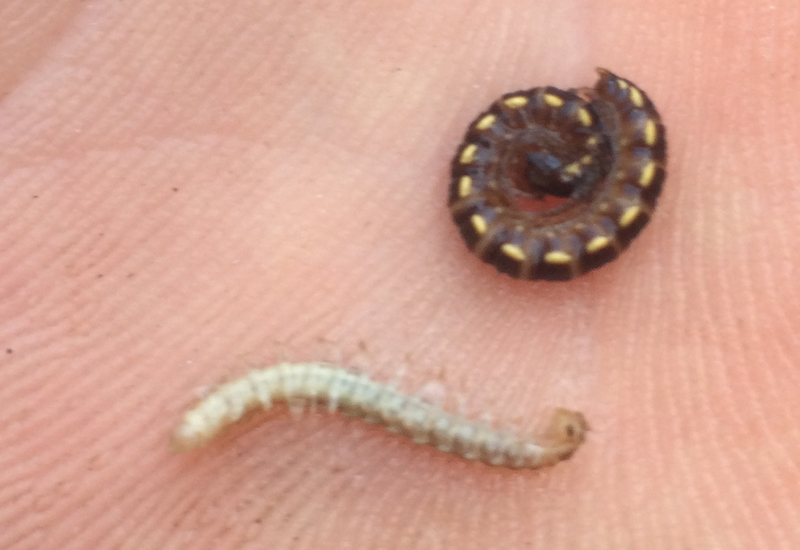Millipedes need damp environments to survive, but what do they do with the moisture? How does a millipede get water from its surroundings? Let’s find out.
[toc]
The word millipede means “thousand-legger,” and a millipede is known for its hundreds of tiny pairs of legs and segmented body.
Millipedes aren’t likely to be your favorite creatures if you are not a fan of creepy crawlies.
But learning about them helps remove such fears and helps us understand that they are unique and harmless little things that were the first creatures to roam the earth.
For example, how much do we know about their feeding habits? In this article, we will be talking about millipedes, their water requirements, and the unique ways in which they get water.

Why Do Millipedes Need Moisture?
The millipede species are natural scavengers, feeding on leaf litter, dead leaves, plants, and mostly rotting organic matter.
They are known as detritivores because of their penchant for eating decaying things. These insects usually seek out damp, dark places because of their high requirement for moisture.
Like all living creatures, millipedes need water to survive. However, they also lack a waxy outer layer to protect them like other bugs, so without moisture, they die quickly.
Tropical species of millipedes can be found mostly around damp places indoors and outdoors.
Millipedes are sensitive bugs that change their habitat and behavior with the seasons, always looking for moist places.
During the dry months of summer and spring, they find their way to buildings and sidewalks, where they can get some extra moisture. They reside in the creaks and corners of the buildings, where it is damp.
How Do They Get Water in the Wild?
Millipedes are terrestrial animals, and the maximum millipede activity can be found in the first few layers of the soil.
These are areas where they find moisture and the required nutrients. Besides this, there are several sources from where millipedes find water:

Absorb Moisture From The Surroundings
Millipedes have segmented exoskeletons, expansion joints, and hundreds of pairs of legs that help them crawl in the soil.
The most important adapting feature of the millipedes is their exoskeleton which helps them retain water through their skin.
Water from Food
Most millipedes feed on organic matter like fresh and rotting fruits and vegetables. These items have moisture content which adds up to their requirement of water.
Bristle Millipedes Can Absorb Moisture From the Air!
One of the most interesting cases is that of the Bristle millipedes species. It is found in the dry areas of North America and Europe.
These millipedes are capable of absorbing water vapor directly from the air. The tiny bristles on their exoskeleton help to retain the water in dry areas.
How To Give Them Water in Captivity?
When you are keeping creepy crawlies like millipedes in captivity, there are a few things you have to remember about their care.
Keeping them in tanks requires you to maintain the substrate, moisture, and temperatures so they can thrive well. Here are a few things you should do to maintain your pet millipede’s home:
Millipedes can drink from a standing container of water.
Keeping a small shallow bowl of chlorine-free water in the tank will allow them to make their way towards and drink from it when needed.
Make sure to add a small stone or pebble for them to climb into and out of the bowl.
Misting the tank with water spray is a good idea to maintain the humidity levels and temperature of the tank.
Using a cricket quencher in the tank can be another good way to provide them with water. This also helps to prevent any kind of bacterial growth in the water source.
Besides these ideas, maintaining the substrate of the tank is one of the best things you can do to keep the millipede hydrated and healthy.

How Do Millipedes Conserve Water in Deserts?
While most millipedes are found in arid lands and damp soils, there are two specific species of millipedes in North America found in a desert areas.
At the Petroglyph National Monument, the Desert millipede and Slate millipede have special ways of surviving in high temperatures instead of moist environments.
Don’t let the water evaporate
Millipedes burrow deep under the ground to escape extreme temperatures in the deserts. Water loss occurs through evaporation and movement.
Burrowing deep in the sand and staying there helps them retain the amount of water they are carrying in their body.
Dig deeper to find more of it
Millipedes always look for more water that will help them survive. In deserts, they keep burrowing deep inside the ground to levels where water can be found.
These areas are damper than the surface, and the worms can comfortably survive here without losing water.

Physical adaptation to conserve water
A lot of insects and animals in the deserts have water-retaining capacity. Millipedes of the desert have a different exoskeleton from the common species.
It is a physical adaptation where the wax coating of their exoskeletons holds moisture and reduces water loss when they are crawling around the surface.
Frequently Asked Questions
What kills millipedes instantly?
If you are trying to remove millipedes from your home, the easiest thing is to vacuum them from walls and corners.
You can try to use bug sprays and insecticides that work effectively to get rid of millipedes. Some natural chemicals like boric acid can also be used to spot-treat millipedes.
Do pet millipedes need water?
Millipedes in any environment need a high moisture content to thrive. If you keep millipedes as pets, you must maintain an adequate temperature and moisture in the tank.
Make sure to maintain a substrate and mist the terrarium to keep the right moisture levels.
What do millipedes need to survive?
Millipedes are creatures of dark and damp areas. They are usually found outdoors in gardens, plants, and soil.
They prefer to live under dead leaves, litter, compost, and flowerbeds. They need a damp zone with high moisture and organic matter as nutrition to survive.
Can I keep a millipede as a pet?
A lot of people find millipedes to be beautiful and fascinating creatures. So yes, keeping these worms as your pet at home is possible.
Most people prefer to keep giant millipedes because, in spite of their size and appearance, these are gentle creatures who are very low-maintenance.
Can millipedes swim?
Yes, but only for a very short period. Millipedes have spiracles underneath their legs, like many other insects, which they use to breathe in oxygen.
If they remain inside water for a long time, they will not be able to breathe in and will drown.
Wrap Up
You think it might be a stretch, but millipedes of all kinds can be called “gentle giants” of the insect world.
These creatures live for 7-10 years, crawling around in your garden or staying healthy in a tank in your living room. They are excellent at keeping dead plants and leaves off your yard.
All they need is a cool body of water, darkness, and some food to keep them going. The choice is up to you. Thank you for reading!
Reader Emails
The way in which millipedes get water is very interesting, as well as quite unique in the world of bugs.
Over the years, many of our readers have wondered about the same. Read on to know all about their findings.
Letter 1 – Millipede Aggregation
 Tiny little worms…
Tiny little worms…
I’m hoping you can help me identify these tiny little worms that have made my children’s bedroom their breeding ground. The pics attached were taken on the patio just off the bedroom. There are hundreds of them outside in the cracks all around the backyard. They have made their way in from the outside and are all around the baseboards. I don’t know what to do about them and can’t identify them. I hope you can help.
Lisa Enriquez

Hi Lisa,
These are not worms, they are Millipedes. They feed on organic material in soil and help break it down. Perhaps you have a new flower bed filled with bags of soil and amendments which has caused this population explosion.
Update: (01/20/2008) Millipede ids.
Here are ids. for the millipedes on the millipede page. Most are quite old; don’t people submit new ones more often than this? 2/19/07 . representatives of the order Julida. Can’t tell family from photo; they are probably introduced as they occur around a home
Rowland Shelley
North Carolina State Museum of Natural Science
Letter 2 – Millipede: Exotic or Canadian???
 Millipede Question
Millipede Question
Dear Bugman,
I bought a tropical plant at Walmart today and when I was transplanting it to a pot we found this little millipede inside. I looked on the net but couldn’t find anything that looked like him/her. Can you tell me what it is? I live in Saskatchewan, Canada. Is this native to Canada? If not, should I release it?
Thank you,
Andre Boutin-Maloney

Hi Andre,
What a lovely Millipede. We are not sure if it is exotic or Canadian. We do not recognize. We would not recommend releasing it until you are sure. Try a local Natural History Museum and we will try additional research on our end.
Update: (01/20/2008) Millipede IDs
10/9/05 . An introduced representative of the tropical family Rhinocricidae (Spirobolida), introduced to Canada where it cannot survive outdoors in winter.
Rowland Shelley
North Carolina State Museum of Natural Science
Letter 3 – Millipede from Ecuador


Subject: Unidentified Bug
Location: Ecuador
October 20, 2014 5:49 am
Hi
I took this picture of a bug in the Amazon, Ecuador.
Can you help to identify it?
Regards
Ian
Signature: Ian Rowlings
Hi Ian,
This is a Millipede in the class Diplopoda.
Letter 4 – Millipede found in Toilet
 Subject: This didn’t come out of my husband, did it?!
Subject: This didn’t come out of my husband, did it?!
Location: Toilet in bathroom in Leawood, Kansas
September 21, 2015 5:50 pm
Dear Bugman,
I found this worm-like caterpillar bug in our toilet coiled up and was concerned it came out of my husband who had used the restroom prior to me. We put it in a plastic cup and it is still moving around, spitting up black ink here and there. Thoughts?!
Signature: Concerned about husband in KS 

Dear Concerned,
You should teach your husband to flush. This looks like a Millipede, and we suspect it fell into the toilet, but we have researched some Soil Centipedes that are reported to crawl up human gastrointestinal tracts.
Thank you for your response! Husband seems to be OK and millipede is safely outside of our home’s jurisdiction.
Letter 5 – Millipedes falling into swimming pool
 Subject: Worm in pool
Subject: Worm in pool
Location: Pensacola Florida
April 5, 2017 7:33 am
Im a maintenance guy at a condo and I’ve been having these worm things invading my pools and the local bug man can’t seem to kill it off plz help.
Signature: Coty

Dear Coty,
This is not a Worm. It is a Millipede, possibly a Greenhouse Millipede, Oxidus gracilis, and according to BugGuide: “Native to Asia, introduced to North America and found throughout the lower 48 states and southern Canada.” The problem is most likely with the landscaping as this is not an aquatic species. It is falling into the pool, not living there.
What would be a good insecticide to help knock them down? I keep all the flower beds and grass around it as clean as possible.
We do not provide extermination advice.
Letter 6 – Millipede Carcass
 Subject: Same as “Possible Hawaiian Centipede!?”
Subject: Same as “Possible Hawaiian Centipede!?”
Location: Nokesville, VA
May 24, 2017 4:43 pm
My daughter & I were exiting a natural wooded trail in Nokesville, VA today (Northern Virginia), when she gasped & stopped at sight of this dragon-like creature. I shot a photo, then tapped it with a stick, & it fell apart into multiple segments sliding off its center. Gross!
It has been very wet here lately, so I thought–once researching this image–that it might not have survived due to our almost nonstop rain this spring, if it’s a desert centipede..! Seeing that another person found one just like ours in Fredericksburg is astounding! That’s only an hour south of where we found ours.
Signature: Lolly

Dear Lolly,
This is NOT a Hawaiian Centipede. You have discovered the remains of a native Millipede, possibly Apheloria virginiensis based on this BugGuide image and according to a comment on that posting: “I’ve seen these here in southern VA; they were common where we lived in southern MD too. They are quite tame, and I have handled them many times without any problems. The cyanide secretion makes them smell just like marzipan! One day in MD I was walking thru the woods and came to a room-sized area of tall dead weed stems, and each one of the stalks had one of these millipedes curled up dead, on top of it. There were at least 50 of them. They had apparently all decided together that it was time to go, like a crustacean Jonestown. Very weird, spooky and sad.” It should be noted however that Millipedes are NOT Crustaceans. Perhaps your individual was preyed upon by a Glowworm.
The post How Does A Millipede Get Water? 3 Ways They Get Moisture From Their Surroundings appeared first on What's That Bug?.
No comments:
Post a Comment